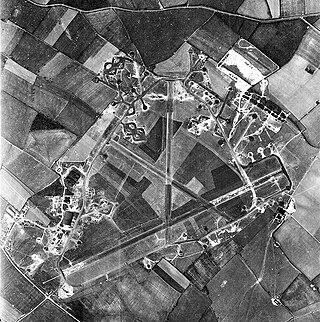Related Research Articles

Royal Air Force Molesworth or more simply RAF Molesworth is a Royal Air Force station located near Molesworth, Cambridgeshire, England with a history dating back to 1917.

Royal Air Force Chelveston, or more simply RAF Chelveston, is a former Royal Air Force station located on the south side of the B645, 5 miles (8.0 km) east of Wellingborough, near the village of Chelveston in Northamptonshire, England. During the Second World War the airfield was occupied by both the Royal Air Force and the United States Army Air Forces. It was given the USAAF designation Station 105.

Royal Air Force Station Polebrook or more simply RAF Polebrook is a former Royal Air Force station located 3.5 miles (5.6 km) east-south-east of Oundle, at Polebrook, Northamptonshire, England. The airfield was built on Rothschild estate land starting in August 1940.

Royal Air Force (RAF) Podington is a former Royal Air Force station in northern Bedfordshire, England, 6 miles (9.7 km) south-east of Wellingborough, Northamptonshire.

Royal Air Force Thurleigh or more simply RAF Thurleigh is a former Royal Air Force station located 5 miles (8.0 km) north of Bedford, Bedfordshire, England. Thurleigh was transferred to the United States Army Air Forces Eighth Air Force on 9 December 1942 and designated Station 111, and used for heavy bomber operations against Nazi Germany.

Royal Air Force North Pickenham or more simply RAF North Pickenham is a former Royal Air Force station located 3 miles (4.8 km) East of Swaffham, Norfolk, England.

RAF Kimbolton is a former Royal Air Force station located 8 miles (13 km) west of Huntingdon, Cambridgeshire, England.

Royal Air Force Grafton Underwood or more simply RAF Grafton Underwood is a former Royal Air Force station located 4 miles (6.4 km) northeast of Kettering, Northamptonshire, England.

Royal Air Force Glatton or more simply RAF Glatton is a former Royal Air Force station located 10 miles (16 km) north of Huntingdon, Cambridgeshire, England.

Operation Frantic was a series of seven shuttle bombing operations during World War II conducted by American aircraft based in Great Britain and southern Italy, which landed at three Soviet airfields in Ukraine. From there, the planes flew bombing missions en route back to their bases in Italy and Great Britain.

Royal Air Force Shipdham or more simply RAF Shipdham is a former Royal Air Force station located 3 miles south of Dereham, Norfolk, England.

Royal Air Force Deopham Green or more simply RAF Deopham Green is a former Royal Air Force station located near Deopham Green 2 miles (3.2 km) north of Attleborough, Norfolk, England.

Royal Air Force Hardwick or more simply RAF Hardwick is a former Royal Air Force station located between the Norfolk villages of Topcroft and Hardwick in England. It is around 5 miles (8.0 km) west of Bungay, Suffolk.

Royal Air Force Attlebridge or more simply RAF Attlebridge is a former Royal Air Force station located near Attlebridge and 8 miles (13 km) northwest of Norwich, Norfolk, England.

Royal Air Force Station Rattlesden or more simply RAF Rattlesden is a former Royal Air Force station located 9 miles (14 km) south east of Bury St Edmunds, Suffolk, England.

The 92d Operations Group is the flying component of the 92d Air Refueling Wing, assigned to the United States Air Force Air Mobility Command Eighteenth Air Force. The group is stationed at Fairchild Air Force Base, Washington.

The 307th Operations Group is an Air Reserve Component of the United States Air Force. It is assigned to the 307th Bomb Wing, Air Force Reserve Command, stationed at Barksdale Air Force Base, Louisiana.

The 340th Weapons Squadron is a United States Air Force unit assigned to the USAF Weapons School. It is stationed at Barksdale Air Force Base, Louisiana. The 340th is assigned to the 57th Wing, at Nellis Air Force Base, Nevada. The mission of the squadron is to provide Boeing B-52 Stratofortress instructional flying.

United States Army Air Forces formations and units in the Mediterranean Theater of Operations (MTO) were the second-largest user of the Boeing B-17 Flying Fortress during World War II. There were a total of six combat groups (twenty-four squadrons) equipped with the bomber assigned to the Theater.
References
- ↑ Staff. Shuttle bombing Archived 2011-05-18 at the Wayback Machine McGraw-Hill's AccessScience Encyclopedia of Science & Technology Online Archived 2008-05-27 at the Wayback Machine
- ↑ Edward T. Russell (1999). Leaping the Atlantic Wall: Army Air Forces Campaigns in Western Europe, 1942–1945 Archived 2004-06-27 at the Wayback Machine (PDF), United States Air Force History and Museums Program Archived 2006-10-28 at the Wayback Machine pp. 26, 27. (HTML Archived 2008-05-16 at the Wayback Machine copy on the website of USAAF.net)
- ↑ Dear, I. C. B.; Foot, M. R. D., eds. (2005). "Shuttle Bombing". The Oxford Companion to World War II. Oxford: Oxford University Press. p. 778. ISBN 978-0192806703.
- ↑ Beevor, Antony (1999). Stalingrad. Penguin Books. p. 138. ISBN 0140249850.
- ↑ Christopher Chant (1986). The Encyclopedia of Codenames of World War II, Routledge, ISBN 0710207182. p. 15
- ↑ Jon Lake (2002). Lancaster Squadrons 1942–43, Osprey, ISBN 1841763136. p. 66
- ↑ Bombardiers lourds de la dernière guerre: B-17, forteresse volante, Avro Lancaster, B-24 Liberator. Editions Atlas. 1980. ISBN 2731200316.
- ↑ Miller, Donald (2006). Masters of the Air: America's Bomber Boys who Fought the Air War against Nazi Germany . New York: Simon & Schuster. ISBN 0743235444.
- ↑ Charles T. O'Reilly (2001). Forgotten Battles: Italy's War of Liberation, 1943–1945 Lexington Books, ISBN 0739101951. p. 343
- ↑ Deane, John R. 1947. The Strange Alliance, The Story of our Efforts at Wartime Co-operation with Russia. The Viking Press. [ ISBN missing ][ page needed ]
- ↑ Combat Chronology of the US Army Air Forces September 1944: 17, 18, 19 copied from USAF History Publications Archived 18 November 2009 at the Wayback Machine & wwii combat chronology (pdf) Archived 2008-09-10 at the Wayback Machine